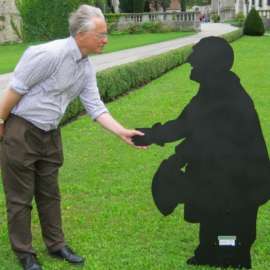Janine Jansen’s performance of the Tchaikovsky Violin Concerto carried all before it: she played with such passion and commitment, with such seaching beauty and endless variety of tone, it left the orchestral contribution seeming somehow colourless and inadequate to the occasion. In the face of such an emotional interpretation from the soloist, Vänskä made no attempt to match it, but steamed unyielding through the first movement ‘big tune’ tutti, and in the many passages of dialogue between soloist and woodwind, the orchestral players’ response often seemed bluff and unresponsive. But Jansen’s contribution made up for it all, and often her virtuoso high speed scales and passage work had a frenetic, demonic quality, head down towards the orchestra as though delivering a challenge to them – one to which they found it impossible to rise. Every melodic phrase was carefully shaped, if repeated it was shaped anew, and the quiet cadences that introduced new themes were breathtakingly hushed and intense.
It goes without saying that the second movement, "Canzonetta", was spell-binding, and there, at last, the clarinet’s quiet arpeggios matched her intensity. In the recitative-like cadenza that opens the final movement, her loud pizzicatos were like pistol shots - it was a surprise that no-one was injured. The whole performance had a breathtaking sweep from beginning to end. As an encore Jansen and some of the orchestral strings played the "Mélodie" from Tchaikovsky’s Souvenir d'un lieu cher, Op.42, arranged for string orchestra, and very beautiful it was too.
In Bruckner’s Fourth Symphony, conductor Osmo Vänskä used the 1888 edition, as he had at the Proms in 2010 with the Minnesota Symphony Orchestra. This was (more or less) the version first published, and played in Bruckner’s lifetime and into the early decades of the 20th century. Thereafter it was dismissed as an inauthentic travesty, full of cuts and re-orchestrations by Bruckner’s young friends (Löwe and the Schalk brothers). But today some musicians and musicologists are seeking to rehabilitate it, pointing out that Bruckner was closely involved in the collaboration and that it contains many performing indications missing from the cleaner ‘original’ version.
I don’t know if it was dislike of this version, or of Bruckner’s music, or of Vänskä’s way with the music, but one member of the audience became so incensed that he leapt up from his seat in the choir and noisily left the hall shouting protests all the way. At that moment we were in the middle of the Finale's second subject group and Vänskä was treating it very fussily - each section’s dynamics carefully moulded and each with its own tempo (as, indeed, this edition of the score calls for). For some reason he had gone straight into the Finale, attacca - without a break - after the Scherzo, so maybe the protester believed the third movement had become interminable and the concert wouldn’t finish before the pubs closed.
But in many ways it was an exasperating performance. The LPO’s playing was not as ravishing as it had been for Eschenhach’s performance of Bruckner’s 7th two weeks previously, and the brass suffered occasional mishaps. The opening horn calls and crescendo to the main theme were played very straight, without atmosphere or expressive nuance, and the bird-song second theme was very quick and chirpy. It seemed as if Vänskä wished to treat it as a classical work, like a rather large Haydn symphony. The movement was lively, and it worked, in a way, but a lot of atmosphere was sacrificed and there were frequent fussy interventions - such as an uncalled-for diminuendo-crescendo in the big brass fanfare that ends the exposition. One might have thought that this edition of the score has plenty enough detailed markings without additional undermining of the large-scale sweep of the work.
The slow movement was probably the most successful, the processional rhythm clearly enunciated, and the cello and viola melodies beautifully (rather than expressively) played. But the climax was fatally undermined by an extraordinary luftpause - pause for breath, not in the score - before its resolution, followed by a weak entry from the brass. The closing pages, with the melodic fragments beautifully played by horn, violas, oboe and clarinet in turn above the steady tread of the funereal timpani, were splendidly done, and there was spontaneous applause after the movement ended.
The Scherzo’s overlay of horn and trumpet calls was brightly and lightly executed, the motives clipped, with a return to the classical, Haydnesque feel of the first movement. With the best will in the world I find it hard to imagine that Bruckner really wanted the ungainly diminuendo into the Trio and the ruggedly abbreviated da capo that happens in this edition - certainly this performance failed to make it sound like well-proportioned whole. A cymbal player had been waiting patiently for his moment at the climax of the Finale's first theme exposition, and he delivered that with élan, but his two pp additions to the coda seemed unhelpful, and the sculpting of the final paragraph strangely inconclusive, as though the symphony had finished before it was over.
It was a performance that raised interesting and provoking questions about how you might perform a Bruckner symphony with a light classical touch, rather than the heavy, monumental and deeply emotional romanticism that is characteristic of most performances, and as such it was a considered and thoughtful approach. But I don’t think it was merely that it followed Janine Jansen’s passionate display in the Tchaikovsky that made me feel that we’d had short measure of the very quality that led Bruckner to call the symphony ‘Romantic’.


